|
Voyageurs National Park lies in a transition area between the southern edge of the boreal forest and the northern edge of the temperate deciduous forest. It is composed of a variety of ecological systems, including conifer forests, hardwood forests, bogs, swamps, marshes, rocky outcrops, and lakeshore environments. The park is home to over 400 wildflower species. Why Wildflowers?From the earliest violets in spring, to the last asters in fall, the forests and wetlands of Voyageurs are alive with color. Over the course of the season, watch the colors change as over hundreds of wildflowers bloom. While we enjoy the beauty of the colors of wildflowers, the colors serve a more important purpose to insects. Like many birds and humans, insects have color vision. The color of wildflowers, as well as their odor and nectar, attracts insects and encourages them to visit and pollinate flowers, often those of a certain type. The varied shapes and color patterns of wildflowers are wonderfully complex, a strategy by which cross-pollination is made more certain. By cross-pollination the genetic inheritance of the plant is maintained and renewed. Insects and plants have long worked together for their mutual benefit. But what is a flower?A wildflower is any flower that is uncultivated and growing freely without human intervention. By definition, a flower is a short stem or shoot, bearing several kinds of leaves modified to aid cross-pollination and the production of seeds. There are four kinds of floral leaves. Starting from the outside, they are sepals (forming the calyx), petals (forming the corolla), stamens (they produce pollen), and the pistil (encloses ovules and later seeds). Native or an Exotic Invader?Native wildflower species are those that naturally occur in an area and exotics are ones that are not naturally occurring or are introduced to an area. Some exotics can become invasive when they out-compete other plants, whether they are native or not. Can I pick the wildflowers?Wildflowers are to be seen, photographed, and admired along with other wild plants but not picked. Voyageurs National Park staff encourages you to follow leave no trace ethics and enjoy all wildflowers without taking them, particularly lady’s-slippers and other orchids. When you pick wildflowers, it is hard to know for sure if it is a native species or an exotic in that area. If the wildflower happens to be an exotic invasive, picking it will help spread the unwanted species. Please help protect resources for future generations. And now, meet some favorite native species.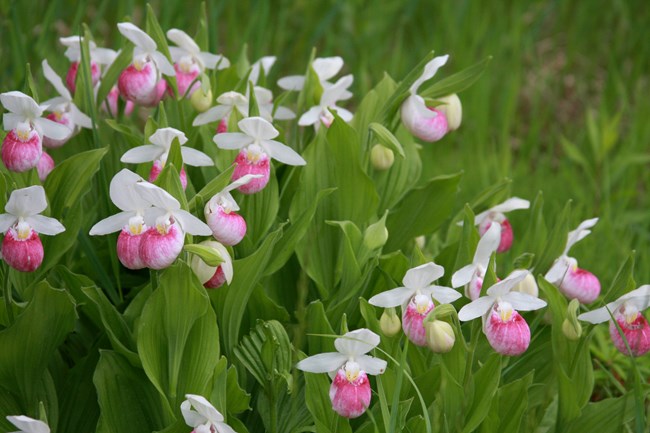
Showy Lady’s-slipper (Cypripedium reginae)The Showy Lady’s-slipper is the state flower of Minnesota and one of 43 orchid species that grow in the state. There are one or two flowers at the top of the stem and the inflated slipper is one to two inches long, white but heavily streaked with deep pink to nearly white. Hairy oval leaves surround the stem. Lady’s-slipper flowers bloom from early June to mid-July near the Kabetogama Visitor Center and along the Cruiser Lake Trail, doing best in bright sunlight but it will grow in semi-shaded areas. Each year the Lady’s-slipper may produce up to half-million seeds, which are as fine as flour dust. Lady’s-slippers have a life span of up to 100 years old. 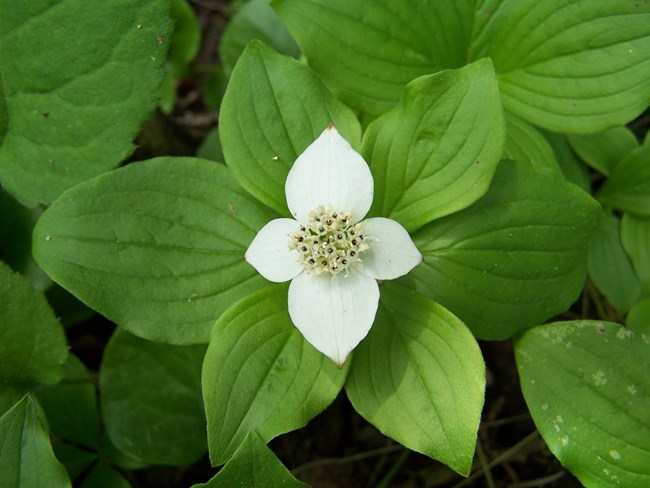
Bunchberry (Cornus canadensis)Bunchberry flowers are a single cluster of tiny greenish to creamy white stalked flowers in the center of four large white bracts that look like petals. The flowers have four creamy yellow stamens and a dark reddish-brown style in the center. The bracts are broadly oval, tapered to a soft point and typically one pair of opposite bracts is slightly larger than the other pair. There are two or three pairs of leaves just below the flower cluster and then a few pair of small opposite leaves along the lower stem. Bunchberry blooms from May to July producing a round berry about 3/16 inch across that ripens to a bright red. You can find large dense colonies of Bunchberries in our northern boreal forests that, regardless of flowers or fruit, produce a stunning display. 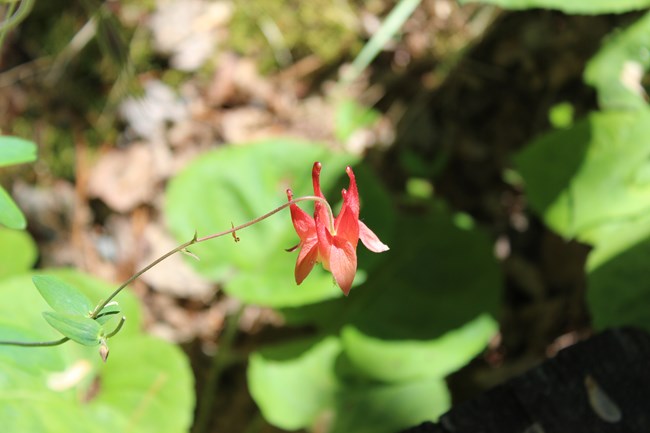
NPS / B. Tallman Red Columbine (Aquilegia canadensis)This is a stunning plant, gorgeous in spring and early summer and popular with pollinators. It most often is found in shadier sites but it will tolerate sun. Columbine plants have an open, branching cluster of hanging, bell-shaped flowers at the top. The upside-down flowers have five yellow petals each rolled into a column and forming a long, red, hollow spur at the top. There are five flaring, red, petal-like sepals alternating with the spurs. A bundle of long, yellow stamens hangs down from the bottom of the bell. The flower is one to two inches long from the tip of the spur to the stamens. Leaves are compound in groups of three, alternating up the slender stem. These flowers are easily recognizable and can be a nice surprise to find if you are hiking in the Kettle Falls Historic District from May to July. 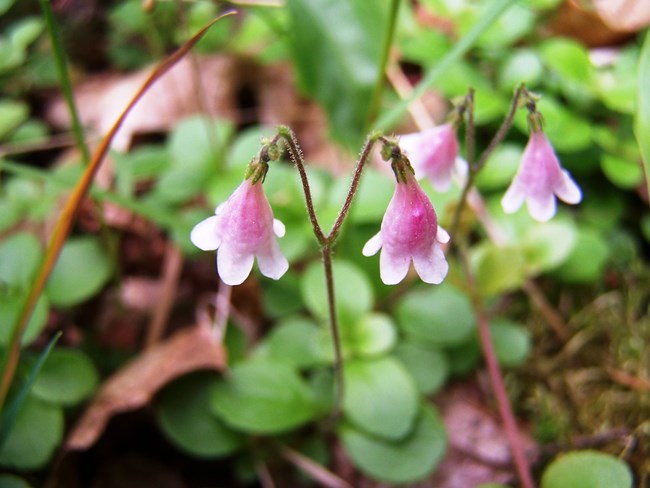
Twinflower (Linnaea boreali)The Twinflower is reported to have been a favorite of Carolus Linnaeus, the father of binomial nomenclature. The Latin genus of the plant (Linnaeus) is named in his honor, and the species (borealis) refers to the northern distribution of the plant. There are a pair of small pink, nodding flowers at the top of a slender, hairy stem that is forked near its top. The funnel shaped flowers have five rounded lobes that are whiter than the tube. These flowers are 1/3 to ½ inch long and smooth on the outside but lined with tiny hairs on the inside. The small calyx holding the flower has five narrow lobes, sharply pointed and densely hairy. You will find these adorable little flowers anywhere in Voyageurs National Park where it is shady to partly shady, blooming from June to August. 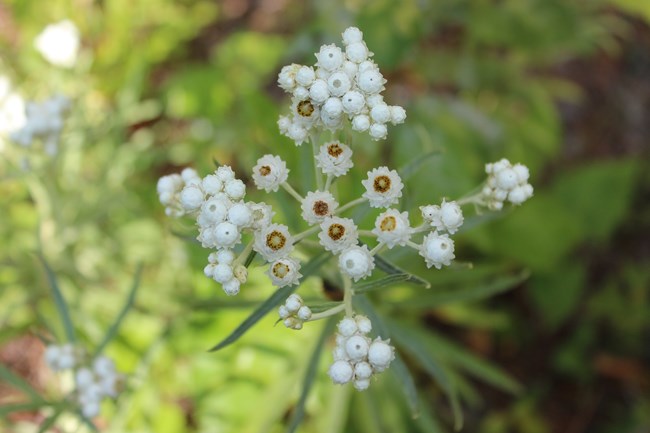
NPS / B.Tallman Pearly Everlasting (Anaphalis margaritacea)Pearly Everlasting can be found along trails and roadsides from July to October. There are flat-topped clusters of numerous ¼ to 1/3 inch flower heads at the top of the plant with separate male and female flowers usually on separate plants. Do you think that these are male or female? Male flowers are globular with numerous slender, erect yellowish-brown staminate flowers in the yellow center disc. Female flowers are globular to egg-shaped with a yellowish to dark brown bristly ring around the top of the flower head. Both genders have numerous tiny white petals, called bracts, in many layers around the center. These bracts on the female flowers do not spread out much until seed starts to form. These flowers bear a small brown seed with a tuft of white hairs to carry it off in the wind. 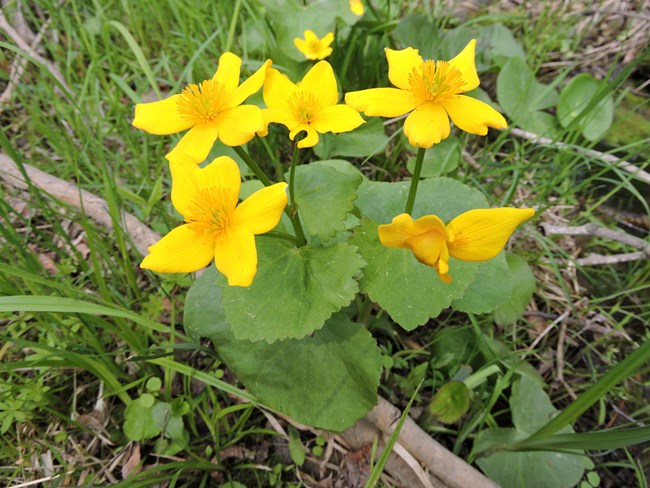
Marsh Marigold (Caltha palustris)Marsh Marigolds can be found blooming in April and May in wetter areas of the park and along shorelines. One good place to look for them is behind and to the right of the Rainy Lake Visitor Center sign as you make the turn from U.S. Hwy 11. These have two to five flowers on a stout, naked stalk at the end of a branching stem, a bit above the leaves. The flowers are a bright yellow, 1 to 1½ inches across with usually five, but can be up to nine rounded petal-like sepals with distinct veins radiating from the base. In the center is a ring of numerous yellow stamens. Leaves are up to four inches long, mostly basal, mostly round to kidney-shaped and deeply heart-shaped at the base on stalks two to six inches long. These plants tend to grow in clumps. When you visit Voyageurs National Park, take time to visit our Ethno-botanical Garden near the Rainy Lake Visitor Center. This garden, a restored native landscape, shares the history of Ojibwe Indians and the plants on which they relied. It reminds us of the significance native plants have in our daily lives from the food you eat to the air you breathe. When you return home, explore the native plants in your neighborhood. |
Last updated: January 30, 2023
